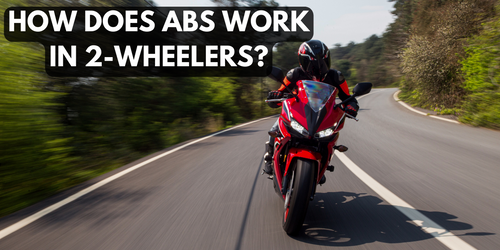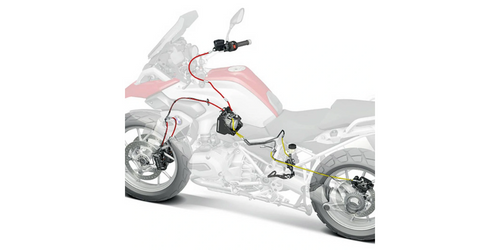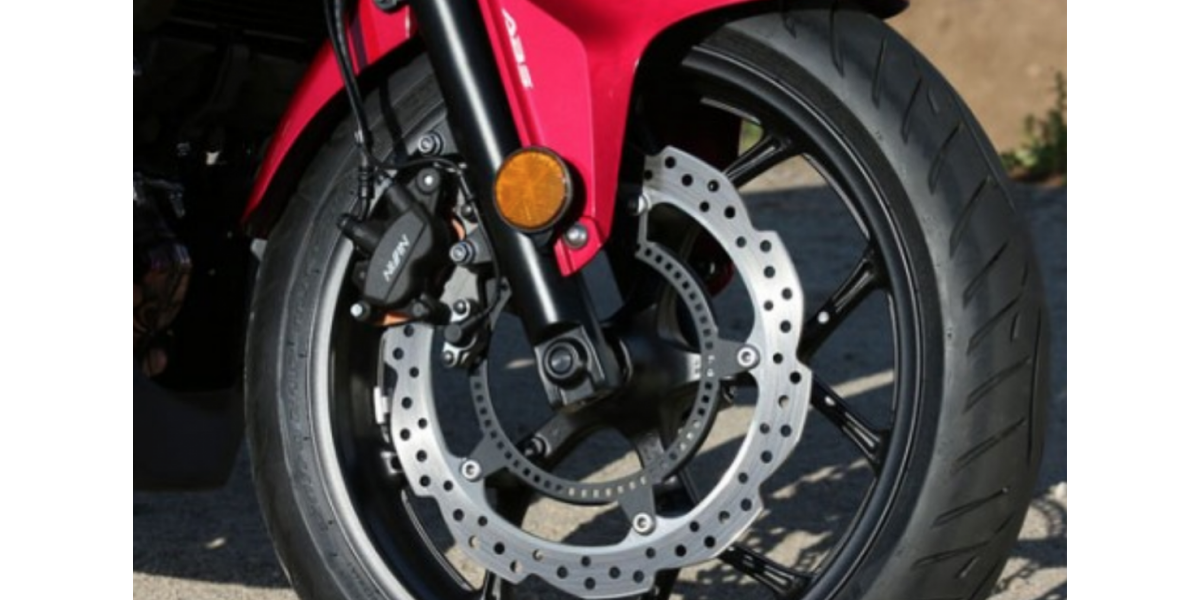ABS 101: How ABS does work in Bikes and Scooters?

3497 Views
Learn the benefits of ABS (Anti-lock Braking System) for bikes and scooters, and how it can prevent skidding and increase your control on the road. The advantages and disadvantages of ABS, and how to apply it properly.

If you are a bike or scooter enthusiast, you might have heard of ABS, or Anti-lock Braking System. And even if you are not an enthusiast, you wouldn’t have helped but to overhear this world renowned vehicle safety feature.
In simple terms, this is a technology that helps you brake safely and effectively, without locking up your wheels and skidding. ABS can prevent crashes, reduce braking distance, and improve handling.
But how does it work? And what are the benefits of having ABS on your bike or scooter? In this article, we will answer these questions and more. We will explain the mechanism and function of ABS, and how it can enhance your riding experience.
What is ABS?
ABS is a safety feature that prevents the wheels from locking up during sudden braking. When the wheel locks up, the rider loses control of the bike or scooter, which may end up skidding and resulting in a possible mishap.
ABS uses speed sensors on both wheels to accurately determine wheel speed as well as sensors to determine when a wheel is about to lock. It adjusts the braking pressure accordingly to prevent the wheel from locking and assists with maintaining the stability of the motorcycle or scooter.
ABS can prevent crashes, reduce braking distance, and improve handling. It is also a useful feature that can enhance your riding experience by reducing braking distance and improving rider safety.
How does ABS work?

ABS constantly monitors the rotation of the wheels and automatically adjusts the braking pressure to the wheel. This ensures the wheels have enough traction and keep rotating despite heavy or sudden braking. This allows for a more controlled and smoother stop, reducing the possibility of an accident, and enhancing the experience of riding a two-wheeler.
Most major bike and scooter manufacturers offer models with ABS as a standard fitment or optional equipment. This allows the riders to ride bikes or scooters without worrying about skidding or losing control during hard braking and avoid life-threatening situations.
What are the types of ABS?
There are multiple types of ABS systems available for bikes and scooters, depending on the number of channels, sensors and valves they use. Some of the common types are:
Single-channel ABS: This type of ABS only works on the front wheel and uses one speed sensor, one hydraulic valve and one ECU. It is cheaper and simpler than other types, but it does not prevent the rear wheel from locking up.
Dual-channel ABS: This type of ABS works on both wheels and uses two speed sensors, two hydraulic valves and one ECU. It is more expensive and complex than single-channel ABS, but it provides better braking efficiency and stability.
Cornering ABS: This type of ABS is an advanced version of dual-channel ABS that can adjust the braking pressure according to the lean angle of the bike or scooter. It uses additional sensors such as gyroscopes and accelerometers to measure the lean angle and modulate the brake force accordingly. It is more expensive and sophisticated than dual-channel ABS, but it offers better safety and performance in corners.
What are the key components of ABS?
ABS consists of several components that work together to provide optimal braking performance. Some of the key components are:
Sensors: These are devices that measure the rotational speed of each wheel and send signals to the ECU. They are usually mounted on or near the brake discs, which have toothed rings or holes that help the sensors detect the wheel speed.
Toothed disc: This is a metal ring with regular teeth or holes that is attached to the brake disc. It helps the sensor measure the wheel speed by passing by it at a certain frequency.
Electronic Control Unit (ECU): This is a mini computer that receives signals from the sensors and calculates the optimal brake pressure for each wheel. It also controls the valves and the pump that regulate the brake fluid pressure.
Valves: These are devices that open and close to allow or block the flow of brake fluid to the calipers. They are controlled by the ECU and can modulate the brake pressure according to the wheel speed and lock-up condition.
Pump: This is a device that pumps brake fluid back into the master cylinder when the valve blocks it from reaching the caliper. It helps maintain a constant brake fluid pressure in the system.
Actuator: This is a device that converts electrical signals from the ECU into mechanical actions for the valves and pump. It can be either solenoid-based or motor-based.
Warning light: This is a light on the instrument panel that indicates whether ABS is working properly or not. It usually flashes when ABS is activated and stays on when there is a fault in the system.
Pros of having ABS:
Improved safety: ABS can prevent the wheels from locking up and skidding during sudden or hard braking, which can cause loss of control and crashes. ABS can help the rider maintain traction and stability on the road, and avoid dangerous situations.
Shorter stopping distances: ABS can reduce the stopping distances, especially on wet or slippery surfaces. This can help the rider react quickly and safely in an emergency braking situation, and avoid colliding with other vehicles or obstacles.
Greater control: ABS can help the rider brake more effectively and smoothly, without losing steering ability. This can improve the handling and maneuverability of the bike or scooter, and enhance the riding experience.
Lower wear and tear: Without ABS, the rider would have to manually release and reapply the brake to prevent the wheels from locking up. This can cause uneven tyre wear and increased stress on the brakes. ABS can mitigate this wear and tear by automatically modulating the brake pressure.
Cons of having ABS:
Higher cost: ABS is usually more expensive than conventional brakes, both in terms of initial purchase and maintenance. Some riders may not be willing to pay extra for this feature, or may not find it worth the investment.
Limited availability: ABS is not available on all models of bikes and scooters, especially those with lower engine capacity or older models. Some riders may have limited options to choose from if they want a bike or scooter with ABS.
Reduced feedback: Some riders may prefer to have more feedback from the brakes, and feel that ABS reduces their sense of control or involvement in braking. Some riders may also find the pulsating sensation of ABS annoying or distracting.
Not optimized: The ABS technology currently used on bikes and scooters is not optimized for all types of systems or conditions. For example, some systems may have only one-wheel ABS instead of two-wheel ABS, which can reduce the braking efficiency. Some systems may also not work well on very slippery surfaces, such as ice, snow, or oil.
Common misconceptions about ABS?
Despite its proven benefits, ABS is still misunderstood by some riders who have some false beliefs about it. Some of these misconceptions are:
ABS makes you stop faster: ABS does not make you stop faster, but it helps you stop more safely and smoothly by preventing wheel lock-up. The actual stopping distance depends on various factors such as road conditions, tyre conditions, rider skill, etc.
ABS works on all surfaces: ABS works best on hard and dry surfaces where there is enough friction between the tyre and road. On loose or slippery surfaces such as gravel, sand, snow, etc., ABS may not work as effectively or may even increase stopping distance due to reduced traction.
ABS eliminates skidding: ABS reduces skidding by preventing wheel lock-up, but it does not eliminate it completely. Skidding can still occur due to other factors such as excessive speed, sudden steering, improper weight distribution, etc.
ABS makes you lazy: ABS does not make you lazy, but it makes you safer. You still need to practice good riding habits such as maintaining safe speed, following traffic rules, keeping adequate distance, etc. ABS is not a substitute for rider skill or common sense.
Conclusion
ABS is a valuable safety feature that can save your life in critical situations. It works by preventing wheel lock-up during sudden braking and helping you maintain control of your bike or scooter. It has many benefits such as improved safety, shorter stopping distances, greater control, lower wear and tear and higher rider confidence.
However, ABS is not a magic solution that can solve all your braking problems. You still need to be aware of its limitations, such as its performance on different surfaces, its effect on skidding, its dependence on other factors, etc. You also need to keep your riding skills sharp and follow good riding practices.
We hope this article has helped you understand how ABS works in bike and scooters and cleared some of your doubts about it. If you have any questions or feedback, please feel free to leave a comment below.
Happy and safe riding!
FAQs:
Q: What is the difference between ABS and CBS (Combined Braking System)?
A: ABS is a system that prevents the wheels from locking up and skidding when you brake hard. CBS is a system that distributes the brake force between the front and rear wheels when you apply either brake. Both systems can improve braking performance and safety, but they work differently.
Q: How can I tell if my bike or scooter has ABS?
A: One way to check if your bike or scooter has ABS is to look for an ABS logo or indicator on the instrument panel or near the brake levers. Another way is to look for a speed sensor and a hydraulic modulator on the wheels. These are the main components of the ABS system.
Q: Does ABS work on all types of surfaces and conditions?
A: ABS can work on most types of surfaces and conditions, such as wet, dry, gravel, sand, etc. However, ABS may not work well on very slippery surfaces, such as ice, snow, or oil. In these cases, you should reduce your speed and brake gently.
Q: Can I turn off ABS on my bike or scooter?
A: Some bikes and scooters have an option to turn off ABS, usually by pressing a button or switch. However, this is not recommended unless you are an expert rider and you know what you are doing. Turning off ABS can increase the risk of skidding and crashing.
Q: Does having ABS mean I can brake later and harder?
A: No, having ABS does not mean you can brake later and harder. ABS is a system that helps you brake safely and effectively, but it does not change the laws of physics. You still need to maintain a safe distance from other vehicles, anticipate hazards, and brake smoothly and progressively. ABS is not a licence to be reckless or overconfident.